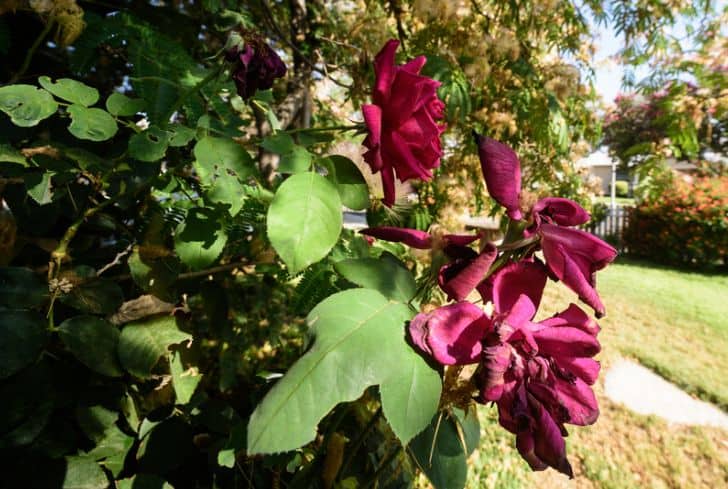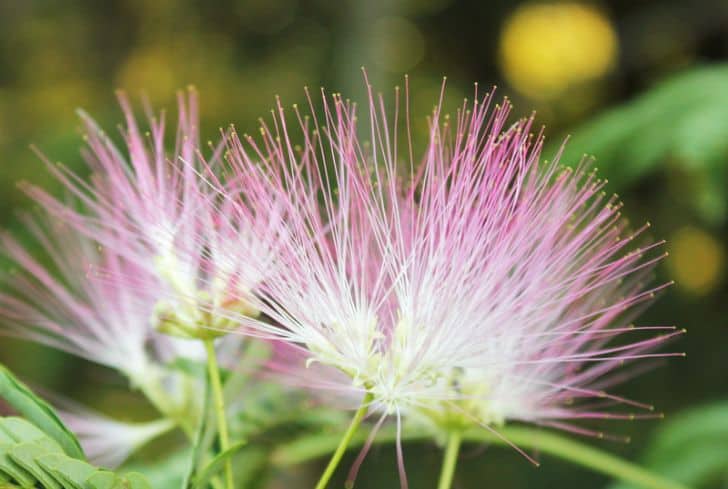With stunning fern-like foliage, unique puffball flowers, and a quick-growing shade tree, it’s no secret that mimosa trees are eye-catching. However, when it comes to adding them to your landscape, you have to plan ahead for mature-sized plants. However, some plants or trees take many years before reaching their full-grown size and shape. So, how fast do mimosa trees grow?
How Long Does it Take to Grow a Mimosa Tree?
Mimosa trees are fast-growing compared to other types of trees and plants. If you are growing your mimosa tree from seed, it will take about three weeks before you see seedlings rising from the soil. You can move the seedlings outdoors once the weather is consistently above freezing. The plant will begin producing flowers once it reaches about 10 feet tall.
There are many reasons why mimosa trees are loved. The tree’s unique foliage and stunning whimsical flowers make the plant truly memorable. Since the trees flower about two weeks after other flowering trees have stopped, mimosa trees have the stage all to themselves.
While the plants are beautiful, they are incredibly messy, dropping seed pods, flowers, and pollen after their two-week bloom. They also have many other drawbacks that make people think twice before picking a silk tree from the nursery.
Do Mimosa Trees Multiply?
When you see mimosa trees dotting the highway or backroads while on a drive, you may wonder how they got there. Did someone deliberately plant them there, or did they grow from wild seeds? How do mimosa trees multiply?
Mimosa trees multiply by seeds. The tree produces flowers in the late spring or early summer each year. The flowers are then pollinated by butterflies, bees, and other pollinators. Once the female flowers have been successfully pollinated, they produce a long, slender green seed pod that contains five or more brown seeds.
The seed pod will remain attached to the tree even after all the leaves have fallen in the autumn. Eventually, the seed pods will detach from the tree. It’s important to rake or remove the seed pods as quickly as possible, as they pose a threat to wildlife and humans. Both the seeds and the seed pods of the mimosa tree are highly toxic.
Seed pods can travel far from the mother tree, spreading throughout the land. Mimosa trees are an invasive species and can thrive in almost any soil. These trees have been known to spread quickly, taking over landscapes and choking out natural plants.
While these plants are quick growing and invasive, they can’t produce flowers of their own until they reach maturity. Mimosa trees grow up to 3 feet each season, and during their initial ten years, they focus all their energy on growing larger before they can store enough energy to reproduce.
How do Big Do Mimosa Trees Grow?
Landscape planning requires the gardener or homeowner to look into the future. You need to plan enough space for each plant, tree, or shrub to grow to its mature and full potential. So when you think of adding a mimosa tree to the area, you have to plan for how big a mimosa tree grows.
Mimosa trees aren’t large trees. With their final height usually between 20-25 feet tall, they make great additions to many types of landscape designs and gardens. The trees also end up lining highways or in forests as their seed pods travel far from the mother tree.
Many people love to plant mimosa trees near their patios as the tree offers dappled shade throughout the summer days. It also isn’t uncommon to see small mimosa trees growing in pots for the first few years of their lives. Keep this in mind. However, mimosa trees are incredibly quickly growing and will outgrow their pots frequently.
How Do Mimosa Trees Grow?
There isn’t really an ideal environment for a mimosa tree to grow in. Since these plants can tolerate droughts, sandy or poor soil conditions, and partial shade, they can grow almost anywhere and seem to almost thrive on neglect.
Mimosa trees are able to grow in a wide range of conditions. Like almost all plants, they perform photosynthesis to create and store energy in their leaves, allowing them to grow taller and produce flowers and new foliage. The more sunlight a tree gets, the more energy it is able to create.
Water is also important, and your mimosa tree should be watered frequently, especially when they are young and in the early springtime, to help promote flower growth.
How Tall Do Mimosa Trees Grow?
Only mature mimosa trees produce the stunning flowers that make the tree so unique. But when is the mimosa tree considered mature, and how tall do mimosa trees grow?
Mimosa trees will reach a mature height of about 20-25 feet tall. The trees will reach this height within the first 8-12 years of their life as they can grow up to 3 feet in height each year.
While it may seem impressive that the mimosa tree reaches its mature height so quickly, it’s important to note that the tree itself only has a lifespan of about 10-20 years, so keep that in mind if you are planning on adding a mimosa tree to your landscape in the near future.
In addition to their short lifespan, many people are turning away from mimosa trees for other reasons. The tree is an invasive species with roots that can lift concrete and damage house foundations. While their root systems are strong and destructive, their limbs are worrisome for a different reason.
Since the mimosa tree grows so quickly, the limbs and trunk are weak. A strong breeze can knock branches from the top of the tree that can fall, hurting pedestrians, wildlife, or property.
Are Mimosa Trees Evergreen?
There are over 1200 varieties of mimosa trees throughout the world. Thanks to the trees’ adaptable personality and people falling in love with their unique foliage, the beautiful plant has been added to just about any type of landscape. This makes us wonder, are mimosa trees evergreen?
While the Albizia mimosa trees of North America are considered to be deciduous trees that lose their leaves when dormant, there are varieties of mimosa trees located elsewhere in the world that is evergreen.
The Albizia varieties of mimosa trees are the ones you see dotting highways and backyard garden spaces throughout the United States. These trees have fern-like leaves, and pink puffball flowers that bloom in the late spring or early summer, usually much after all the other flowering trees have already faded.
In Australia, the Acacia dealbata is another variety of mimosa trees with fern-like evergreen leaves and stunning yellow flowers. This variety blooms in the early springtime, blanketing the world in bright yellow flowers in March each year.
Are Mimosa Trees Hard to Grow?
Like most invasive plants, you seem to find mimosa trees growing in many non-ideal environments. However, many plants that grow well in the wild can be difficult to grow or cultivate in your own garden space. Are mimosa trees hard to grow?
Mimosa trees are considered easy to grow as they thrive in almost any soil and in most USDA zones in the continental United States. In addition to their tolerant nature, these trees are also incredibly fast-growing. Sometimes, mimosa trees can add 3 feet in height in a year.

You can grow mimosa plants from seed or purchase trees from a local nursery. However, since the plant is considered invasive, some nurseries may not stock mimosa trees in hopes of helping curb the number of plants being grown.
If you know someone with a mimosa tree, you can gather seeds from theirs once the seed pods begin to dry out. Seeds in the pods have a long life as well. Even after five years, many seeds still show up to 90% viability.
It’s not always a good idea to dig up and move a mature mimosa tree as they are weak and can break apart easily. Mimosa trees are also susceptible to a fungal disease that can enter the tree through physically damaged roots.
Are Mimosa Trees Deer Resistant?
Deer have been known to foil many landscapes and gardens, looking for a tasty and easily acquired treat. No wonder we want to know if a plant is deer resistant before adding it to our yards.
While some plants are more sought after by deer than others, a deer will eat almost anything if hungry enough. So instead of calling something deer-resistant, it’s best to think of them more as plants or trees that wouldn’t be a deer’s first choice for food.
Mimosa trees are not attractive to deer and can be considered deer resistant. However, there are many reasons that you may not want to plant a mimosa tree in your yard. The species is incredibly invasive and destructive. The seeds and seed pods are also toxic to humans and animals.
Keep in mind that deer resistance does not function as a deer repellent. Instead, the deer-resistant plants tend to be left alone by deer without discouraging them from the area. Planting a deer-repellent plant can keep deer from wanting to physically enter your yard. You can also purchase deer repellent sprays and tonics at your local garden center or make your own using spent coffee grounds.






